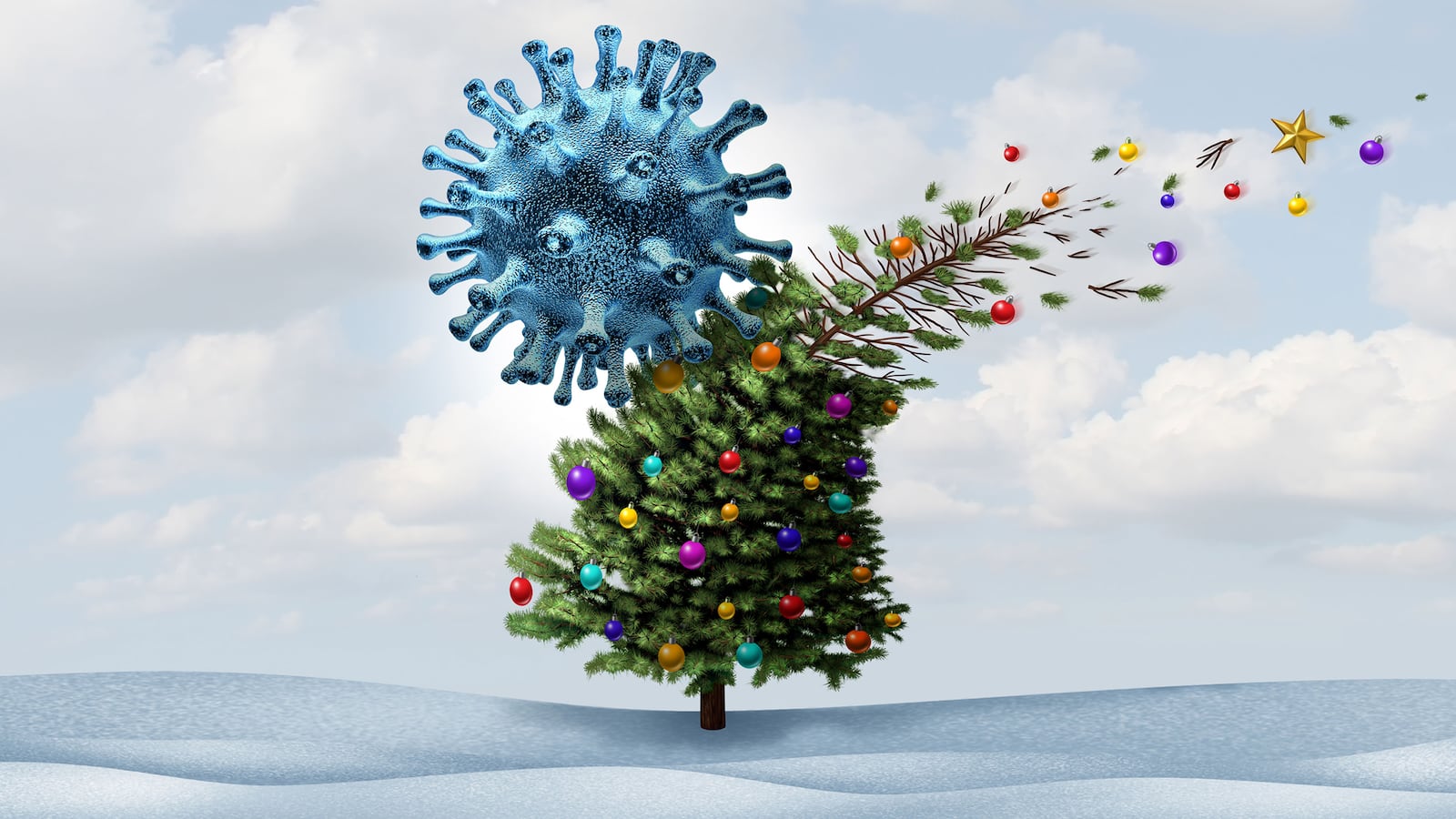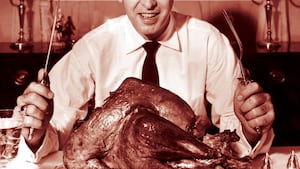Allow me to ruin your holiday season with two words: Zoom caroling.
My apologies. But perhaps it’s best that we face up to the prospect, because it’s coming. You know it is. Old traditions are being bent and broken. New traditions are being forged.
Thanks to the coronavirus pandemic, we’ll be traveling less. And even if we live close to friends and family, it’s not yet safe to gather in large groups. Don’t do it.
And the whole idea of belting out particulate-laden holiday tunes—next to people we hardly know? That seems more David Lynch than Currier and Ives. (“Do You Fear What I Fear?”) And let’s not get started on the practical and aesthetic implications of singing while masked.
It’s evident we’re entering into a much altered holiday season. What’s less clear is exactly how that will affect long-standing traditions of gathering, carousing, eating and drinking. It’s also unclear what new joyous and (perhaps) lasting traditions will emerge from this unwelcome vacuum.
What might lie ahead? Let’s look to the past, at how other major disruptions have impacted the American holiday season, curbing some activities and giving rise to others.
By the middle of the 19th century, many secular American holiday traditions had been well established, mostly by importing them wholesale from Europe. Among them: The singing of carols, the drinking of Eggnog with friends and the tromping through a forest to cut down a sapling and haul it home to festoon it.
The Civil War disrupted much of that.
“‘Merry Christmas,’ said I to myself, for want of a larger family circle,” wrote a soldier named Wilder Dwight of the 2nd Massachusetts Infantry Regiment to his mother on Christmas morning in 1861.
Between 1861 and 1865, once tight-knit families became scattered, with hundreds of thousands of conscripted males of fighting age spending holidays in rough encampments, far from the comforts and rituals of home, both north and south. “Family ties are never so close as in these days of separation and trial,” Dwight later wrote.
Another soldier, Nathaniel Dawson, wrote to his girlfriend hundreds of miles away that same year, “I wish I could be with you at Christmas, the festal season, where age is rejuvenated and lives again in the merry carols of youth.”
Historians often point out that the Civil War reshaped the American Christmas. Before, it had been regarded as a community event. But the bitter realities of war shifted the family to front and center in importance, and enshrined the holiday as something less carnivalistic and more private and family-oriented.
The year 1918 brought a double-header. World War I was winding down—Armistice Day was November 11 that year. And the Spanish influenza pandemic, which had ravaged parts of the nation earlier that summer, sat crouched and ready to spring to life again, even more virulent than before.
Christmas traditions were, naturally, reshaped. One near-casualty: the Christmas tree.
“Shall We Make This a Treeless Christmas?” asked the headline of a Salt Lake City newspaper in 1918. The paper cited reasons of forest and energy conservation, but also noted that the optics of gathering around a tree was actually unpatriotic given the long and brutal war against the Huns from whom we had borrowed the tree tradition. But no. “It would be carrying out anti-Teuton prejudices to a rather pointless length, perhaps, to give up the Christmas tree just because we Americans adapted the custom from the German settlers of Pennsylvania.”
Still, the paper urged readers to celebrate by embracing other traditions, those “in line with our allies, whose Christmas traditions, as rich in poetry and romance as ours, have nothing to do with a Christmas tree.” Suggestions included gathering mistletoe and the ceremonial lighting of a yule log. (“Sometimes in England the dead roots of an old uprooted tree are used. This is regarded as especially auspicious.”)
The Christmas tree survived. And other traditions were born.
Between 1929 and 1933, the United States saw national unemployment rates soar as high as 24.9 percent. This had a clear impact on the holidays. “In some towns…the question actually has been raised as to whether or not Christmas should be observed in the customary way...because of the depression,” a Pennsylvania newspaper noted in 1931, and wondered “whether there should be lights and decorations and trees and exercises.” The correct answer, it turned out, was yes. “As a matter of fact, they are needed more than ever before,” the paper concluded.
An Alabama newspaper found an upside to the downside in 1932. In previous years, finding the right holiday gift could be vexing and stressful. “But the last year or two have been different,” the paper cheerfully noted. “It hasn’t been hard to think what to give anyone. The needs of intimate friends and relatives are more apparent than they used to be.” (An electric sewing machine, the paper noted, was always welcome.)
Another ancient holiday tradition that got a boost from the Depression? That orange in the toe of a stocking. It had been around for centuries (some speculate that it’s somehow linked to a symbolic bag of gold), but during the Depression an orange would have been a rare treat, something enjoyed on a special occasion but not regularly. It’s a tradition that has persisted in some modern households, and now serves as a lesson in disappointment for children expecting something perhaps more shiny and less perishable.
The Second World War rained pessimism and austerity down upon the holiday seasons. What it left in its wake was a marriage of patriotism and consumerism.
As is often the case during wartime, raw materials for manufacturing went into war goods, leaving consumers to scramble for what was left. (Mechanical wind-up cars of scarce tin and Christmas lights were especially in short supply; publications ran patterns for Christmas tree ornaments readers could make at a home with scraps of paper and cloth.) And thanks to blackout regulations, even the tree at Rockefeller Center—which first arose during the Great Depression—went unlit for four years.
Despite the scarcities, the government encouraged Americans to buy for the holidays, both to buoy the domestic economy and to purchase gifts to send to troops overseas to help morale. Consumption became patriotism. The shopping season was moved up earlier to ensure enough time to ship gifts off to distant military outposts.
“Some social critics believe that the holiday shopping madness that now begins months before Christmas—as well as the emphasis on gifts rather than religious observance—had its origin in World War II,” writes Terry Berger in America in World War II magazine.
The war also helped introduce a new canon of Christmas songs. Bing Crosby’s “I’ll Be Home for Christmas”—sung from the perspective of a soldier longing to be home—quickly rose to number one after its release in 1943. (BBC banned its broadcast in Great Britain, fearing it would dampen citizen morale.) The invention of what might be called the “Bing Crosby Christmas”—with the attendant holiday movies and songs, and Christmas parties—arose in the wake of the war.
It’s obviously still too early to write the history of how the Covid-19 pandemic will affect the holiday season, but let’s look at harbingers.
2020 is shaping up to be the year of the remote holiday. And that may include shared drinks. I’ve spoken with folks who are mailing out kits with samplers of liquor and mixers to far-flung friends and kin, so they can gather around the holiday Zoom and share the same drinks at the same time.
Others told me that, while they can feel entrapped with the Zoom squares, in some ways it’s a blessing. The holiday phone calls to grandparents and distant relatives have often felt perfunctory and rushed, something you squeeze in before sitting down for the family meal. But with greater distances between ever greater numbers of family members, the group video chat is becoming more important—more main dish than side dish. Those who’ve traditionally been exiled to the edge of the family circle may feel closer to the center.
Zoom holiday get-togethers. Outside dome dining. The demise of the office Christmas party. (The last being proof that not all traditions should be sacrosanct.) Change came quick in 2020, but surveying past centuries proves that the holiday traditions have never been fixed—they’ve accreted and been edited, been embraced and rejected. It’s just that the pace of change quickens in times of disruption. Are you surprised that we’re moving toward a more digital holiday future? I didn’t think so. But it may be a surprise that it all happened so quickly.
Welcome to Christmas future.







